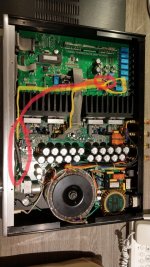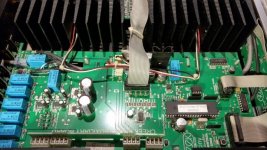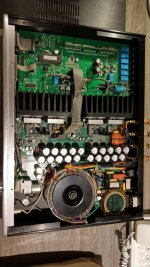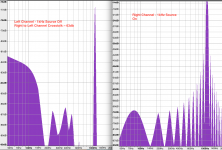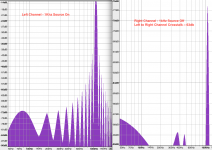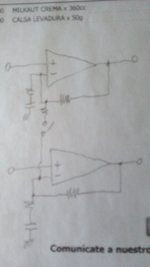Hi All,
The published specs are 60db so it doesn’t surprise me I’m still in the ballpark.
The analog source is a 1kHz sine wave from a DAC with one RCA plugged into the Aux input opposite of the channel being tested for crosstalk.
I used my DMM to measure AC voltage at the the amp speaker terminals, without speakers.
Measurements are as follows: 170mV vs 0.5mV. Crosstalk is 20*Log(V1/V2) = 50db. It’s a few db worse crosstalk from left to right. I’ve been able to double check my measurements using the amp headphone output connected to the input jack on my Mac, recording that input on Audacity and then running a FFT analysis. The 50 db crosstalk is consistent and gets worse as frequency increases, as expected.
Is the most likely cause capacitive coupling via the L/R channel wires (marked in red) that go from the Input board to the volume control and back? These wires, 3 per channel, converge to a 6 wire conductor with shielding, and a drain wire that is connected to ground. The cable length is about 2 feet. The signal then goes through the mute relay to a pair of wires (marked in yellow) that connect to the left and right Amp sections. I think the sequence is Input to Volume to Pre Out to Mute relay to Amp In. Running in Passive preamp mode. I’ve attached photos with and without the markings. See pages 2,8, and 9 of the attached schematics for reference.
I’m wondering if there is a way to improve the crosstalk? One idea is using a Cat7 ethernet cable which has shielded pairs, outer shielding and a drain wire. Or just running separate wires which would take more space. Or is there a lot more that is causing the crossover? And is troubleshooting 50db really worth the trouble? I should add one motivator to replace those wires is a bigger voltage spike (barely audible) in the right channel when changing inputs. Any help is appreciated. If anything, learning more about crosstalk sources would be great.
The published specs are 60db so it doesn’t surprise me I’m still in the ballpark.
The analog source is a 1kHz sine wave from a DAC with one RCA plugged into the Aux input opposite of the channel being tested for crosstalk.
I used my DMM to measure AC voltage at the the amp speaker terminals, without speakers.
Measurements are as follows: 170mV vs 0.5mV. Crosstalk is 20*Log(V1/V2) = 50db. It’s a few db worse crosstalk from left to right. I’ve been able to double check my measurements using the amp headphone output connected to the input jack on my Mac, recording that input on Audacity and then running a FFT analysis. The 50 db crosstalk is consistent and gets worse as frequency increases, as expected.
Is the most likely cause capacitive coupling via the L/R channel wires (marked in red) that go from the Input board to the volume control and back? These wires, 3 per channel, converge to a 6 wire conductor with shielding, and a drain wire that is connected to ground. The cable length is about 2 feet. The signal then goes through the mute relay to a pair of wires (marked in yellow) that connect to the left and right Amp sections. I think the sequence is Input to Volume to Pre Out to Mute relay to Amp In. Running in Passive preamp mode. I’ve attached photos with and without the markings. See pages 2,8, and 9 of the attached schematics for reference.
I’m wondering if there is a way to improve the crosstalk? One idea is using a Cat7 ethernet cable which has shielded pairs, outer shielding and a drain wire. Or just running separate wires which would take more space. Or is there a lot more that is causing the crossover? And is troubleshooting 50db really worth the trouble? I should add one motivator to replace those wires is a bigger voltage spike (barely audible) in the right channel when changing inputs. Any help is appreciated. If anything, learning more about crosstalk sources would be great.
Attachments
Last edited:
What happens, if you connect only the inputs from the right channel (and disconnect speaker from right channel) and listen to the left channel (check also the other way around) ??Why is found as a problem?
For getting best results concerning lowest possible cross talk you need consequently dual mono stages after the using source. I. e. mono RIAA/Line-pre-amplifier, like that one under
https://www.audiosciencereview.com/...mono-preamplifier-by-2r-vintage-review.32203/
and mono power amplifiers.
Dual mono integrated amplifiers like Victor's AX-M9000 - go to
https://audio-heritage.jp/VICTOR/amp/ax-m9000.html
are very rare - check out this thread:
https://www.diyaudio.com/community/...-integrated-amp-very-special-and-rare.196007/
Under
https://www.stereophile.com/integratedamps/107creek/index.html
I read this:
In his view, the Creek Destiny ($2200) is such a giant step up in design and sound from its predecessor, the $1495 5350SE, that it requires entirely new nomenclature
I could not get it confirmed in a listening test longer time ago - for me sound quality of the 5350 was much more better.
Speakers was Wilson Audio "CUB" first series
https://www.wilsonaudio.com/products/cub/cub-series-1
and cd player a Micromega SOLO - also first series.
Last edited:
Ok. I know well that the ideal of crostalk would be zero or -oo (minus infinite dB, no infinite char), but -50 is still a good measure.
I remember some circuits which deliverately mix small amounts (2 to 5%) of both channels to create a "spatial effect". And if actually don't know if those 50dB are in voltage or power at the output, but in any case it represent negligible ammounts. An analog FM tuner has 20 to 30dB of separation.
I remember some circuits which deliverately mix small amounts (2 to 5%) of both channels to create a "spatial effect". And if actually don't know if those 50dB are in voltage or power at the output, but in any case it represent negligible ammounts. An analog FM tuner has 20 to 30dB of separation.
What happens, if you connect only the inputs from the right channel (and disconnect speaker from right channel) and listen to the left channel (check also the other way around) ?? That’s exactly how I measured the crosstalk 🙂.What happens, if you connect only the inputs from the right channel (and disconnect speaker from right channel) and listen to the left channel (check also the other way around) ??
For getting best results concerning lowest possible cross talk you need consequently dual mono stages after the using source. I. e. mono RIAA/Line-pre-amplifier, like that one under
https://www.audiosciencereview.com/...mono-preamplifier-by-2r-vintage-review.32203/
and mono power amplifiers.
Dual mono integrated amplifiers like Victor's AX-M9000 - go to
https://audio-heritage.jp/VICTOR/amp/ax-m9000.html
are very rare - check out this thread:
https://www.diyaudio.com/community/...-integrated-amp-very-special-and-rare.196007/
Under
https://www.stereophile.com/integratedamps/107creek/index.html
I read this:
In his view, the Creek Destiny ($2200) is such a giant step up in design and sound from its predecessor, the $1495 5350SE, that it requires entirely new nomenclature
I could not get it confirmed in a listening test longer time ago - for me sound quality of the 5350 was much more better.
Speakers was Wilson Audio "CUB" first series
https://www.wilsonaudio.com/products/cub/cub-series-1
and cd player a Micromega SOLO - also first series.
What’s causing the crosstalk here? The amp section is dual mono. Is that still a main source of crosstalk? And/or Is the Input wiring in the preamp section a likely source?
Last edited:
ThanksWhat happens, if you connect only the inputs from the right channel (and disconnect speaker from right channel) and listen to the left channel (check also the other way around) ??
For getting best results concerning lowest possible cross talk you need consequently dual mono stages after the using source. I. e. mono RIAA/Line-pre-amplifier, like that one under
https://www.audiosciencereview.com/...mono-preamplifier-by-2r-vintage-review.32203/
and mono power amplifiers.
Dual mono integrated amplifiers like Victor's AX-M9000 - go to
https://audio-heritage.jp/VICTOR/amp/ax-m9000.html
are very rare - check out this thread:
https://www.diyaudio.com/community/...-integrated-amp-very-special-and-rare.196007/
Under
https://www.stereophile.com/integratedamps/107creek/index.html
I read this:
In his view, the Creek Destiny ($2200) is such a giant step up in design and sound from its predecessor, the $1495 5350SE, that it requires entirely new nomenclature
I could not get it confirmed in a listening test longer time ago - for me sound quality of the 5350 was much more better.
Speakers was Wilson Audio "CUB" first series
https://www.wilsonaudio.com/products/cub/cub-series-1
and cd player a Micromega SOLO - also first series.
Just a comment about measurement setup: make sure the input to the unused channel is either shorted or terminated with a reasonable source impedance. An open input is unfairly susceptible to stray coupling.
Thank you, good new and bad news. I shorted the unused channel. The right to left channel crossover looks good at 60db. The left to right channel crossover is far worse around 45dB-50dB. I spot checked all the connections and haven't been able to remedy the issue so far.Just a comment about measurement setup: make sure the input to the unused channel is either shorted or terminated with a reasonable source impedance. An open input is unfairly susceptible to stray coupling.
To localize the crosstalk path, I think we need more circuit detail. Can you post schematics and/or block diagram details?What’s causing the crosstalk here? The amp section is dual mono. Is that still a main source of crosstalk? And/or Is the Input wiring in the preamp section a likely source?
The complete schematics with traces are attached in post #1. I can't find any block diagrams.To localize the crosstalk path, I think we need more circuit detail. Can you post schematics and/or block diagram details?
Thanks. Was right in front of me. 😳
So right channel seems to be the more susceptible channel for crosstalk ingress.
One experiment is to disconnect JP101 (Sheel 3 of 7) and short across the input to the power amp section. Now the isolation check at the right output will tell you if the ingress come in ahead of the volume control or some non-obvious path after the control.
A different experiment would disconnect the left channel PA. Now isolation check at right output will tell you if ingress comes via the left PA or before the volume control because left PA drive has been disabled.
Perhaps this will get you started on identifying the path. I'll be curious about your findings and we can brainstorm from there.
Good luck!
So right channel seems to be the more susceptible channel for crosstalk ingress.
One experiment is to disconnect JP101 (Sheel 3 of 7) and short across the input to the power amp section. Now the isolation check at the right output will tell you if the ingress come in ahead of the volume control or some non-obvious path after the control.
A different experiment would disconnect the left channel PA. Now isolation check at right output will tell you if ingress comes via the left PA or before the volume control because left PA drive has been disabled.
Perhaps this will get you started on identifying the path. I'll be curious about your findings and we can brainstorm from there.
Good luck!
Update on measurements after shorting the unused channel
Crosstalk Left to Right with 1kHz sine wave - 42db!
Crosstalk Right to Left with 1kHz sine wave - 60db
However, I isolated the crosstalk!
It turns out it is the 7-conductor cable marked in red, that runs from the input to volume control and back! The cable is shielded but the 7 wires twist once every 2 feet. I replaced the left channel with a unshielded ethernet cable. Apparently twisted pairs make the difference!
Cross talk is now 60db+ in both channels!
I used this website as the signal generator and left/right panning.
https://www.szynalski.com/tone-generator/
And Audacity to record from the amp headphone output.
https://www.audacityteam.org/
Attached are the screenshots of the crosstalk. Unfortunately I didn't save the a screenshot of the Left to Right channel crosstalk before the fix!
Thanks again for the help!!
Now that I have a working setup I will use cat7 or cat8 cable as my input line cable.
Crosstalk Left to Right with 1kHz sine wave - 42db!
Crosstalk Right to Left with 1kHz sine wave - 60db
However, I isolated the crosstalk!
It turns out it is the 7-conductor cable marked in red, that runs from the input to volume control and back! The cable is shielded but the 7 wires twist once every 2 feet. I replaced the left channel with a unshielded ethernet cable. Apparently twisted pairs make the difference!
Cross talk is now 60db+ in both channels!
I used this website as the signal generator and left/right panning.
https://www.szynalski.com/tone-generator/
And Audacity to record from the amp headphone output.
https://www.audacityteam.org/
Attached are the screenshots of the crosstalk. Unfortunately I didn't save the a screenshot of the Left to Right channel crosstalk before the fix!
Thanks again for the help!!
Now that I have a working setup I will use cat7 or cat8 cable as my input line cable.
Attachments
Last edited:
I didn't know about the spatial effect, that is interesting and it would increase with frequency. Yes, and phono cartridges are 40db at best! I'm reading a few reports that anything above 40db is inaudible to most listeners. The issue I saw in the FFT, before finding the solution, shows higher (1kHz+) order harmonics, since crossover increases with frequency, amplified in the right channel vs the left channel. Still, I don't know if this is audible. This has been an educational exercise is crossover and cable wiring.Ok. I know well that the ideal of crostalk would be zero or -oo (minus infinite dB, no infinite char), but -50 is still a good measure.
I remember some circuits which deliverately mix small amounts (2 to 5%) of both channels to create a "spatial effect". And if actually don't know if those 50dB are in voltage or power at the output, but in any case it represent negligible ammounts. An analog FM tuner has 20 to 30dB of separation.
Last edited:
I have an schematic of a cassette player (don't remember its brand now) in which there is a simple switch connecting the two amplifiers of a stereo toguether with a resistor. They did that in the return of the NFB loop so its sum is partial and changed of sign (say, L - kR and R -kL with k<1). Let me see if I can find it.
Thanks!The true circuit is at a book in mum's house. When I go, I take a pic. But rougly the idea was this:
The true circuit is at a book in mum's house. When I go, I take a pic. But rougly the idea was this:
Update: Replaced all internal input wiring with a single Cat7 cable I found on "A" which has shielded twisted pairs (STP), outer shielding, and a drain wire. Channel crosstalk remains the same at 63dB with a 1kHz sine wave. Also, the right channel thumping on changing inputs is gone! The only caveat is working with 26awg wire is delicate.Update on measurements after shorting the unused channel
Crosstalk Left to Right with 1kHz sine wave - 42db!
Crosstalk Right to Left with 1kHz sine wave - 60db
However, I isolated the crosstalk!
It turns out it is the 7-conductor cable marked in red, that runs from the input to volume control and back! The cable is shielded but the 7 wires twist once every 2 feet. I replaced the left channel with a unshielded ethernet cable. Apparently twisted pairs make the difference!
Cross talk is now 60db+ in both channels!
I used this website as the signal generator and left/right panning.
https://www.szynalski.com/tone-generator/
And Audacity to record from the amp headphone output.
https://www.audacityteam.org/
Attached are the screenshots of the crosstalk. Unfortunately I didn't save the a screenshot of the Left to Right channel crosstalk before the fix!
Thanks again for the help!!
Now that I have a working setup I will use cat7 or cat8 cable as my input line cable.
- Home
- Amplifiers
- Solid State
- Troubleshooting 50 dB left right channel Crosstalk on Creek Audio Destiny Integrated Amplifier
